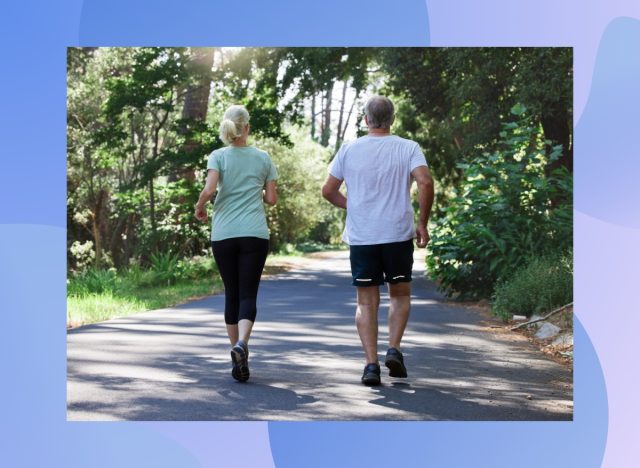The One Walking Trick That Helps You Burn More Fat All Day

While it may seem counterintuitive, the mental and emotional benefits of intentional walking are key to what makes it a powerful practice for burning fat. An intentional walk is when you choose to step away from your screens, your work, and your obligations for some period of time – be it 10 minutes or 90 minutes – to take a walk. It offers an opportunity for you to clear your mind, connect with your body, and get some exercise. And while all walking is good walking (so go ahead and park at the far end of the parking lot), an intentional walking practice not only gets your body moving but also helps to reduce levels of the stress hormone cortisol, elevated levels of which have been associated with weight gain. In addition, minimizing stress throughout the day reduces cravings for nutritionally poor food, reduces stress eating, connects us more fully with our bodies, and improves sleep – a trifecta of fat-burning benefits.
And, of course, there are the physical benefits: the calories expended during every walk and the boost to our metabolism that can continue beyond the walk itself. Read to discover the walking tricks that help you burn fat all day.
Bookend your day: benefits of a morning and evening walk

While all walking is good walking, there are specific benefits that result from walking at different times of day, and one way to maximize caloric burn is by bookending your day with a morning and an evening walk.
How? Simply add two walks to your days, one in the early morning hours, ideally shortly after the sun rises, and the second one in the evening after dinner.
Why? The morning walk will help to set your circadian rhythm, fire up your creativity, boost your decision-making capabilities, and wake up your metabolism for the day to come. Not only will you begin your day with calorie expenditure, you will also start your day in the best mindset to make calm, deliberate decisions throughout your day.
In addition to extra caloric burn, your post-dinner walk will help move digestion along, settle your body down for rest, and may encourage you to make better decisions during dinner time because, once you've created this routine, you will quickly learn that your after-dinner walk feels a whole lot better after a meal of lean protein and veggies than it does after a dinner loaded with heavy, fried foods. Finally, for some, this evening walk can disrupt tendencies towards post-dinner snacking.
Add Intervals

Intervals involve alternating high-intensity exercise with low-intensity recovery, and research has shown that they are very effective in boosting your metabolism.
How? Interval training is pretty straightforward. You simply alternate between short bursts of high-intensity exercise and periods of lower-intensity recovery. It can be done in a huge variety of contexts, including walking and can easily be adapted no matter your level of fitness. Begin by alternating 20 seconds of high-intensity work with about a minute of recovery. There are a variety of ways to achieve the high intensity you are looking for. You can dramatically increase your pace, find a hill or set of stairs to climb or add some arm movements while you walk – think overhead pressing, or arm circles. Your goal is to increase your heart rate to a level that is safe for you (hence the importance of a doctor's clearance before beginning interval training) and challenging. Slowly build up the duration of your interval walking sessions until you can maintain the interval cadence for 20 to 30 minutes.
Why? Interval training has been shown to be incredibly effective for burning calories while also being super time-efficient. Less time, more calories. In addition, interval training fires up your metabolism and that increase can continue even after the walking session is over.
Load it Up

I am a huge advocate for weighted walking. Whether you toss a few books into a backpack, wear a weighted vest, or invest in a plate carrier or rucksack designed specifically for the task, adding load to your walk is a simple and powerful way to increase the fat-burning power of your walking practice.
Why? Rucking, or walking with a weighted load, increases calorie burn by adding resistance to your walks. While the exact increase in caloric output varies based on a host of factors including the weight of your pack, the terrain on which you are walking, your overall level of fitness and your unique physiology, research suggests that rucking can torch between 2 and 3 times the calories of a typical walk. And the added resistance helps to build muscle and more muscle equals increased metabolism, even at rest.
How? You can begin to experiment by simply putting a few books into a well-fitted backpack but as you continue to grow your rucking practice, you'll want to invest in a pack or plate carrier designed specifically for the purpose of adding load to your walk. Start slowly, perhaps with just 5 or 6 pounds for a one mile walk twice a week and build from there. It is very important that you build up your rucking tolerance slowly over time and you may find your shoulders, hips or even your feet are a bit sore as you get stronger. Odor-free products like Aspercreme can help take the edge off those everyday aches and pains, so you're not slowed down by discomfort. Strive to get to the point where you can carry what feels like a relatively heavy load for you (this number will be different for everyone) for a several mile walk twice a week.
What role does nutrition play in getting the most fat-burning benefits from walking?

When it comes to getting the most fat-burning benefits from walking, nutrition plays a huge role. Walking is an incredible, low-impact way to burn fat, but what you eat determines whether your body is primed to tap into those fat stores efficiently.
First, it's important to understand that fat-burning happens when your body has the right balance of macronutrients and energy availability. If you're constantly spiking your blood sugar with processed carbs or fueling up with too much sugar before a walk, your body will prioritize burning that quick energy instead of stored fat. Instead, focus on whole, nutrient-dense foods that help you maintain stable blood sugar.
To maximize fat burn, consider walking in a fasted state – another benefit of that early morning walk. Research suggests that this encourages your body to tap into stored fat for energy rather than using the food you just ate to power your walk. Keep in mind that fasted walking isn't for everyone, so listen to your body. If you do need a little something before your walk, keep it light with a bit of protein combined with a bit of complex carbs.
At the end of the day, consistency is what matters most. Pairing solid nutrition with a regular intentional walking practice will help your body become more efficient at burning fat while keeping you energized and strong.
What kind of realistic results can you expect after 30 days of using these tricks?

If you are diligent about your walking practice and your nutrition, you are likely to begin to see the scale move a bit after 30 days. But we all know that weight loss is a long, slow journey. To that end, the most valuable thing you are likely to notice after 30 days of an intentional walking practice is that you feel better and those positive feelings – physical, mental and emotional – are the fuel that you need to keep going as you create habits and routines that will help you not just achieve a healthy weight, but maintain that healthy weight for the rest of your life.
What common challenges have you observed among your clients, and how has that shaped your approach?

The three top challenges that stand in the way of my clients moving forward toward their fitness, wellness, and weight goals are:
The "why bother" mentality. This block manifests itself in a variety of ways. For instance, when someone typically takes a two-mile walk but only has enough time for a one-mile walk, rather than taking that one-mile walk, they think, "why bother" and do nothing at all. It also comes up when someone eats something that doesn't align with their nutrition plan (think … a danish for breakfast), tells themselves that the day is ruined, and think "why bother" eating well the rest of the day. Or, when someone is on a weight loss journey, has a week when the scale doesn't move and thinks, "why bother" continuing to try.
Failing to align physical activity and nutrition. How you nourish and fuel your body is intrinsically connected with how you feel, how you move, and what you see when you hop on the scale. Nevertheless, people often address one without the other and are then surprised when they don't get the results they want. Simply put, whether you are on a weight loss journey, seeking to maintain a healthy weight, or hoping to live as long, active and healthy a life as possible, you must align both your physical activity and your nutrition.
Letting minor aches and pains derail you. My practice specializes in working with people in their 50s and beyond, and the reality is that, at our age, physical activity – from walking to running to pickleball to strength training – is likely to result in some minor aches and pains.
As long as your doctor's on board and you use it as directed, an over-the-counter option like Aspercreme—which is clinically proven and made for things like everyday aches and pains—can really help you stay comfortable, odor free, and keep doing what you love, so you can act your age! After all, age makes you interesting, pain makes you dull.









